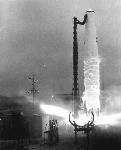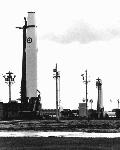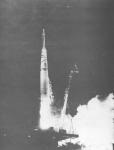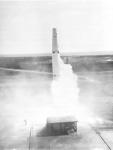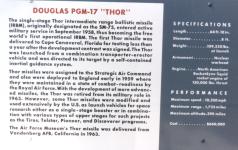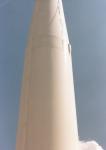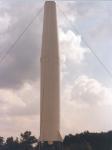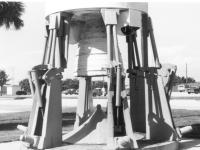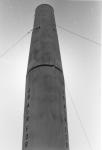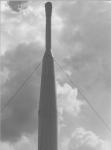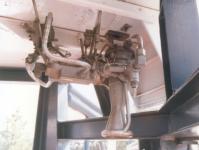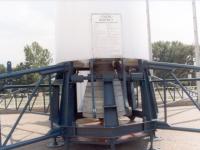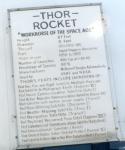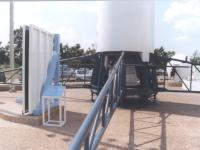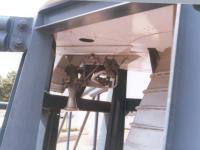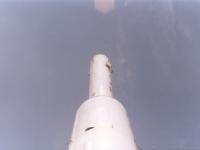





The Thor, developed for the Air Force by the Douglas Aircraft was single-stage, liquid-fueled, rocket-powered (150,000 pounds of thrust) ballistic missiles equipped with all-inertial guidance. The Thor was stored horizontally on tactical field-deployed launchers. The missile could be fueled and fired to an effective range of 1,500 nautical miles upon approximately 15 to 20 minutes notice.
On 22 March 1956, Headquarters USAF assigned responsibility for Thor's initial operational capability Jointly to the Air Research and Development Command and the Strategic Air Command. Thor IOC would consist of one wing of 120 missiles, situated at three SAC bases in the United Kingdom. Each base would have four soft, dispersed launch complexes containing five launchers. Planning called for the first 10 Thor IRBMs to attain combat status by October 1958, and the entire
120-missile force by 1 July 1959. After a month and a half of negotiations, ARDC and SAC completed a Thor IOC agreement on 7 May 1956. Under terms of the agreement, ARDC's Western Development Division would develop, man, train, and equip operational Thor units. The Strategic
Air Command would deploy operational units overseas and bring them to combat readiness.
The Thor development program, like Atlas and Titan, underwent a series of changes. On 28 March 1957, President Eisenhower approved a revised Thor IOC plan calling for 60 missiles (four squadrons of 15 missiles each). The first of the squadrons was scheduled to become operational by July 1959 and the entire force by July 1960. The plan was revised once again following the Soviet Union's success with Sputnik I. The new IRBM plan approved by President Eisenhower and the National Security Council on 30 January 1958, would deploy four Thor IRBM squadrons, each squadron possessing 60 missiles. The first Thor squadron would attain operational status by 31 December 1958, and the entire force of 60 IRBMs would be operationally deployed by March 1960. Additional changes to the plan were made late in FY 1958 and in FY 1959.
The first Western European nation to receive American-made IRBMs was Great Britain. On 25 March 1957, the last day of the Bermuda Conference, President Dwight D. Eisenhower and British Prime Minister Harold MacMillan issued a joint communique announcing a broad agreement on the deployment of Thor IRBMs in the United Kingdom. Eleven months later, the two governments signed an agreement providing for the deployment of four Thor IRBM squadrons to England. Headquarters SAC activated the 705th Strategic Missile Wing (IRBM-Thor) on 20 February 1958 at Lakenheath Royal Air Force (RAF) Station, United Kingdom, to monitor the Thor IRBM program in the United Kingdom and provide technical assistance to the four RAF Thor squadrons. Shortly thereafter, the Air Force transferred the 705th SMW to South Ruislip and merged it with Headquarters 7th Air Division.
Transferred to the Royal Air Force on 22 June 1959, the 77th RAF Strategic Missile Squadron at Feltwell, England became the first British-based Thor IRBM squadron to reach operational status. At the same time, SAC retained control over the squadron's nuclear warheads and assigned a detachment to perform four functions: (1) retain custody and control over, and provide maintenance for, reentry vehicles and warheads; (2) receive and initiate U. S. warhead release orders; (3) operate USAF communications facilities; and (4) provide training to the Royal Air Force. On 11 September and 22 December 1959, the second and third British-based Thor IRBM squadrons were declared operational and assigned to Royal Air Force personnel. When SAC turned over the fourth and final British-based Thor IRBM to the Royal Air Force on 22 April 1960, the deployment of the Thor IRBM weapon system in the United Kingdom was completed.
Secretary of Defense Robert S. McNamara informed British Minister of Defense Peter Thorneycroft on 1 May 1962 that the United States would not provide logistical support to the Thor squadrons in Britain after 31 October 1964. On 24 January 1963, President John F. Kennedy confirmed that Jupiter IRBMs would be phased out as announced by the Italian and Turkish Governments.
In response to Secretary McNamara's announcement, the British government decided to phase out the four Royal Air Force Thor IRBM squadrons rather than assume the burden of maintaining an obsolete weapon system. On 1 August 1962, Minister Thorneycroft announced in Parliament that Thor would be phased out by the end of 1963. Operational phaseout was planned for 30 September 1963, while technical and equipment deactivation was scheduled for completion no later than 31 December 1963.
The Strategic Air Command's 7th Air Division was the Air Force's single point of contact for Thor in the United Kingdom. The 7th Air Division planned and carried out the phaseout of the four Royal Air Force Thor squadrons. On 29 November 1962, the first Thor came off alert at the 98th Royal Air Force SMS in Driffield. Nine months later, on 15 August 1963, the last 15 Thor IRBMs were declared non-operational. The technical and equipment portion of the Thor phaseout program was completed on 20 December 1963, and SAC ended responsibility for the Thor program in the United Kingdom.
The 4300th Support Squadron at Vandenberg AFB, California, conducted one of SAC's last Thor launches on 8 February 1967. The following month, SAC transferred its remaining Thor boosters to Air Defense Command. When the Air Force reorganized Aerospace Defense Command on 1 November 1979, SAC reacquired the Thor boosters. However, SAC transferred the last modified Thor space booster on 4 September 1981 from the 394th ICBM Test Maintenance Squadron, Vandenberg AFB, California, to storage facilities at Norton AFB, California.
Specifications |
|
